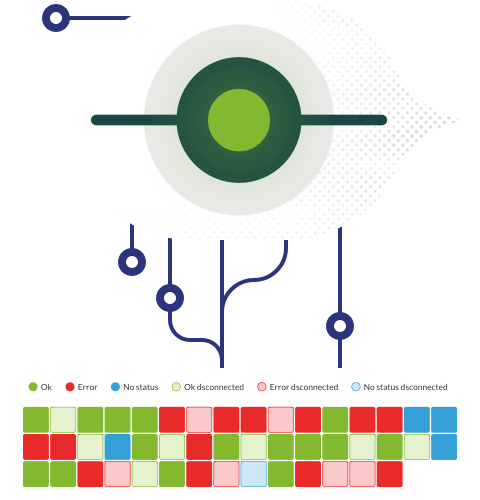What are MAC addresses, what are they for and how to find them?
At the shadow of the widespread IP addresses, MAC addresses say even more about our devices than its more popular sister.
As a kind of “identity document for network devices”, a MAC address informs us about “who is who” when connecting to a network. Of course, remember that the one called “MAC” has nothing to do with Macintosh computers. In fact, you can find it on devices of any brand.
In this article we will find out what the MAC address of a device is, what it is for and how to find yours in a very simple way.
What are MAC addresses?
MAC, or “Media Access Control” is the unique identifier that hardware manufacturers assign to the network card of each of the devices they make in order to be unambiguously identifiable when accessing any network (which of course includes the Internet).
MAC addresses are made up of 48 bits, represented by hexadecimal digits. Translated to a more understandable language, this means that the MAC addresses will consist of 12 digits (both letters and numbers) divided into 6 pairs usually separated by a colon (although they will not always have this separation). So, MAC addresses will have a structure like this one: 00: xx: 01: xy: x0: y1 (for example).
And now you may wonder… how is it possible for each number to be different? How does a software manufacturer know that the MAC number it is giving to a device has not already been used by another manufacturer? Well, it’s very simple: part of the MAC address, in fact, is made up of manufacturer identifiers. Particularly, the first 6 digits of the address tell you what the device manufacturer is, while the last 6 are those that the manufacturer assigns to that specific device.
What is the MAC address for?
As we said at the beginning of this article, the MAC address is something like the “identity document” of network cards that your devices use. It is the identifier that a device must “present” before accessing a network and through which it is going to be recognized, with what this entails. Thus, for example, a network administrator can allow or deny access to a network depending on the MAC of the device that wants to connect.
In theory, the MAC address is registered by the device manufacturer, so it would not be possible to modify it, but you know that in life almost nothing is impossible, so some people are capable of, at least, making the network members believe that the MAC address is a different one from the real one.
How can you find out the MAC address of a device?
As you can imagine, the way to access this information will depend on the operating system you are using. Let’s see how to do it in some of the most common ones.
-If you have Windows:
- Press Windows + R keys (that will open Run).
- Type cmd and press Enter. That way you will access the Command Prompt.
- Type ipconfig /all.
- If you look at the Physical Address you will find the MAC address of your computer.
-If you use Linux:
- Access the system console
- Once there, type iconfig.
- Find the field HWaddr. That is the MAC address.
If you use macOS:
- Go to System Preferences.
- Click on Network and, within the left board, select the one you are connected to.
- Click on the Advanced button, which you may find at the bottom of the window.
- Select the Hardware tab. There you may find the MAC address.
-If you use Android:
- Go to Configuration
- Click on Wi-Fi and select the option Advanced settings
- Nothing else. You will find the MAC address at the bottom of the screen.
-If you use iOS:
- Go to Settings.
- Click on General and once inside, choose the option Information.
- Do you see the field Wi-Fi Address? There you have your MAC.
And now, a little bit of monitoring
Now that you have discovered what the MAC address is, what it is for, and even how to find out your computer’s address, how about taking a few minutes to explore the exciting world of system monitoring?
System monitoring is responsible for supervising technology (hardware, networks and communications, operating systems or applications, for example) in order to analyze its performance, and to detect and alert about possible errors. And that leads us to Pandora FMS, that wonderful tool thanks to which this blog is possible.
Pandora FMS is a flexible monitoring software, capable of monitoring devices, infrastructures, applications, services and business processes.
Would you like to find out more about what Pandora FMS can offer you? You’re on the right path! Find out clicking here.
If you have to monitor more than 100 devices, you may also enjoy a FREE 30-day Pandora FMS Enterprise TRIAL . Get it here .

Dimas P.L., de la lejana y exótica Vega Baja, CasiMurcia, periodista, redactor, taumaturgo del contenido y campeón de espantar palomas en los parques. Actualmente resido en Madrid donde trabajo como paladín de la comunicación en Pandora FMS y periodista freelance cultural en cualquier medio que se ofrezca. También me vuelvo loco escribiendo y recitando por los círculos poéticos más profundos y oscuros de la ciudad.
Dimas P.L., from the distant and exotic Vega Baja, CasiMurcia, journalist, editor, thaumaturgist of content and champion of scaring pigeons in parks. I currently live in Madrid where I work as a communication champion in Pandora FMS and as a freelance cultural journalist in any media offered. I also go crazy writing and reciting in the deepest and darkest poetic circles of the city.

















